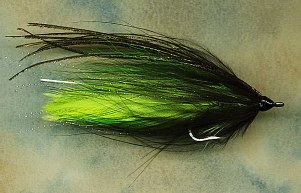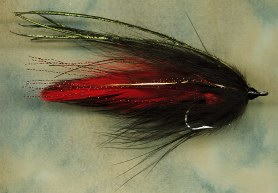Invicta Flies - Cove Runner
The Cove Runner is light and easy to cast, perfect for hitting the shallows from a distance. Send it running just outside grass beds near shore. Its light weight lets you strip it just under the surface.

Hook: Mustad 34007, #1/0-2/0
Thread: 3/0 waxed Monocord, black
Tail: green saddles, flanked by chartreuse saddles
Body: medium chenille, insect green
Wing: Pearl Krystal Flash, chartreuse bucktail, green bucktail, Flashabou (perch)
Colloar: black marabou
Topping: peacock herl
Head: tying thread coated with Loon's Hard Head, black
Tying Instructions:
1) Cover shank with thread, ending at the bend. Tie in four green saddles, two on each side, the tips curving inward, length equal to two times the hook length. I find it easiest to tie the bundle in as is, without trimming the fibers from the tie-in area- place the bundle of four feathers against the top of the shank, leaning slightly toward you, take a couple loose turns of thread, pull down to tighten and position the feathers, then take a few more tight wraps to secure. Clip the excess and cover the exposed butts with the thread.
2) Tie a chartreuse saddle feather on each side the same length. Clip the excess and cover the butts.
3) Expose the core of the final 1/4 inch of chenille. Tie in the chenille by this core at the bend, then wind the thread forward to one and a half hook-eye widths behind eye. Wrap the chenille forward to the thread, tie off, and clip the excess.
4) Tie in six strands of pearl Krystal Flash on top of the shank. Divide so equal bundle fall naturally to either side of the tail. The tips should extend just beyond the tips of the tail.
5) Clip a bundle of chartreuse bucktail about a half matchstick in bulk and remove the shortest fibers. Even up any extra long fibers by pulling them out and realigning them with the bundle. Tie this bundle to the top of the shank, holding it in place as you pull down on the tying thread. The tips should extend to about a hook gap width from the tip of the tail. Clip the butts at an angle and cover with thread. Cement for durability.
6) Tie a small bundle (1/3 matchstick) of chartreuse bucktail on the underside of the shank. Tips should be somewhat even and not quite reach the hook bend. Clip the butts at an angle and cover.
7) Tie a half matchstick size bundle of green bucktail on top, the tips extending just beyond the tips of the red bundle (between the red bucktail and the tip of the tail. Clip and cover the butts.
8) Select six full peacock herls with unbroken tips, leave the ends slightly uneven, and tie them in on top of the black bucktail so they extend about a hook gap beyond the tip of the tail. Clip the excess.
9) Tie in two strands of Perch Flashabou on each side, extending to tip of tail.
10) Select a black marabou feather with long, narrow-tip fibers. Stroke the fibers back and tie in by tip on top of the hook toward the near side. Wind about four times, stroking the fibers back as you go. It is often helpful to wet the fibers a little. Tie off and clip the excess. Wind the thread back over the marabou fibers to secure them and lean them toward the rear.
11) Smooth out the head with the tying thread, whip finish, and cement well. When the cement has dried, apply two coats of Loon's Hard Head in black, allowing ample time for each layer to dry.
NOTES: other good color combinations include black & red, and yellow & red. Keep the marabou collar black and match the chenille to the lighter color bucktail. The darkest color bucktail should be on top.
